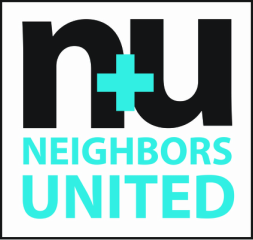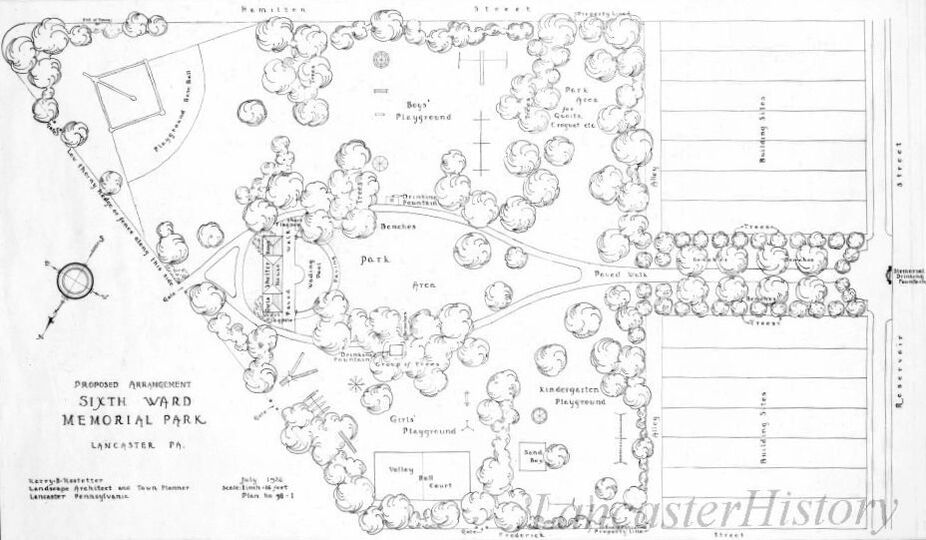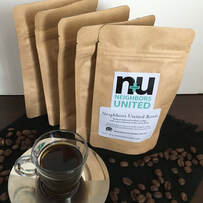1920s
Like much of the country, Lancaster City's Northeast in the 1920s was experiencing a time of prosperity and positive outlook. It was during this time in our history that we witnessed a surge of civic and neighborhood engagement.
UNPRECEDENTED GROWTH
Many of the City's industries, clustered along the railway running on the northern border, fueled a demand for housing in the new development on the site of the former McGrann Park. Residents enjoyed a walkable city within the City, supporting many small businesses, the grand Fulton Market House and neighboring Fulton Hotel, churches and the new Clay Street School. By the mid-1920s, a building boom was quickly taking away many of the neighborhood's remaining open lots for residential development.
WAR, PEACE and BASEBALL
Following the World War, it became equally important to find appropriate ways to honor the memory of those who never returned, and provide the young people of the Sixth Ward with a permanent place for sports and recreation. Baseball, America's favorite past time, was played on a field behind the market on the former McGrann Park site -- many of the local industries and neighborhoods had their own teams. Earl Rebman, a prominent business owner, was concerned that baseball teams never knew where they were going to play next. Together with Henry Goos, the Aument brothers, and with the blessing of Mayor Frank Musser, he suggested purchasing land in the Sixth Ward to be set aside for recreational use. He ran a neighborhood carnival that raised $4,000 towards the initial purchase of land.
The Sixth Ward Soldiers' Memorial Park and playground honored the boys who died in the World War and established a permanent gathering place for recreation and sports in the Sixth Ward. On June 27, 1927 the playground opened.
LEADERSHIP
1926 Martin M. Harnish - President of Sixth Ward Memorial Park Association
The Sixth Ward Memorial Park Association officially chartered December 1926
1927 Mayor Frank C. Musser - President of the Sixth Ward Memorial Park Association
Henry Goos and Charles C. Mackey - Committee Chairs
1929 John Cochran - President of the Sixth Ward Memorial Park Association
Many of the City's industries, clustered along the railway running on the northern border, fueled a demand for housing in the new development on the site of the former McGrann Park. Residents enjoyed a walkable city within the City, supporting many small businesses, the grand Fulton Market House and neighboring Fulton Hotel, churches and the new Clay Street School. By the mid-1920s, a building boom was quickly taking away many of the neighborhood's remaining open lots for residential development.
WAR, PEACE and BASEBALL
Following the World War, it became equally important to find appropriate ways to honor the memory of those who never returned, and provide the young people of the Sixth Ward with a permanent place for sports and recreation. Baseball, America's favorite past time, was played on a field behind the market on the former McGrann Park site -- many of the local industries and neighborhoods had their own teams. Earl Rebman, a prominent business owner, was concerned that baseball teams never knew where they were going to play next. Together with Henry Goos, the Aument brothers, and with the blessing of Mayor Frank Musser, he suggested purchasing land in the Sixth Ward to be set aside for recreational use. He ran a neighborhood carnival that raised $4,000 towards the initial purchase of land.
The Sixth Ward Soldiers' Memorial Park and playground honored the boys who died in the World War and established a permanent gathering place for recreation and sports in the Sixth Ward. On June 27, 1927 the playground opened.
LEADERSHIP
1926 Martin M. Harnish - President of Sixth Ward Memorial Park Association
The Sixth Ward Memorial Park Association officially chartered December 1926
1927 Mayor Frank C. Musser - President of the Sixth Ward Memorial Park Association
Henry Goos and Charles C. Mackey - Committee Chairs
1929 John Cochran - President of the Sixth Ward Memorial Park Association



